Project
Overview
CSE599D/EE590A - Physics of Computation: Energy in Computing
By: Brody Mahoney
Project
Overview
CSE599D/EE590A - Physics of Computation: Energy in Computing
By: Brody Mahoney
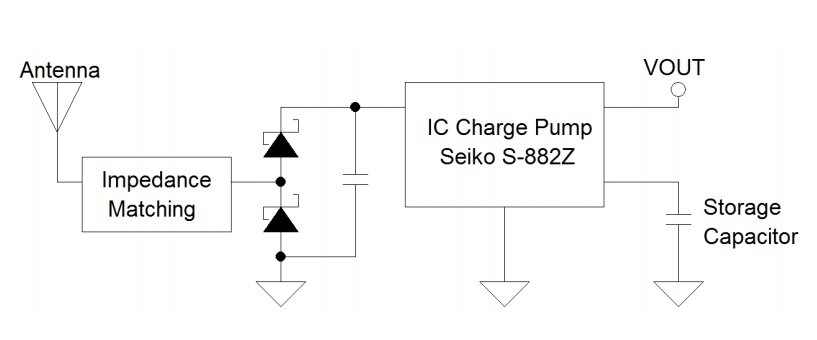
Fig. 1
Most energy harvesting devices that scavenge energy from low-power AC signals require conversion to DC. This is necessary for two reasons: First, many applications have a DC payload. Second, the energy needs to be stored because consumption of the payload is higher than the harvesting rate. Therefore the device must operate on a duty cycle. Fig. 1,a block diagram of a WISP system, is an example of a device that harvests RF energy. This particular version incorporates Schottky diodes and a Seiko Charge Pump, both of which perform extremely well. However, even the Schottky diodes have a forward voltage drop of a few hundred mV. Furthermore, the charge pump in this design is also limited by a few hundred mV.
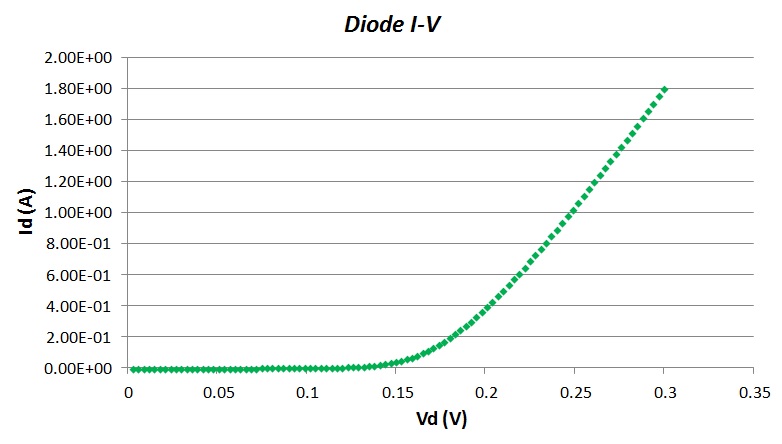
Fig. 2
From Fig. 2 and 3, the limitations of diodes become clear. The data is from a simulated Schottky diode. Fig. 2 shows the familiar IV characteristic. However, if we model the IV curve as a piecewise linear function, we can think of the diode as type of resistor. Fig. 3 shows such a simplification. It was obtained by differentiating the IV curve in Fig. 2. It is obvious that as the forward voltage across the diode approaches zero, the resistance assumes extremely large values.
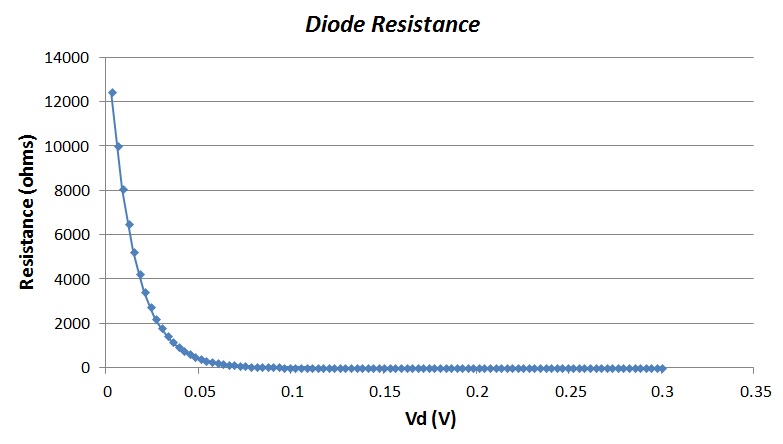
Fig. 3
In 1928 Johson was the first person to experimentally measure thermal noise []. Later Nyquist developed an accurate theoretical model to explain Johnson’s findings []. Thermal noise in resistors can be thought of as a type of Brownian motion. Due to thermal agitation, random instantaneous currents are produced in a conductor. Thermal noise is approximately white, meaning it has a constant power spectral density. This is not completely accurate because thermal noise is bandwidth limited: it tapers off in the THz range.
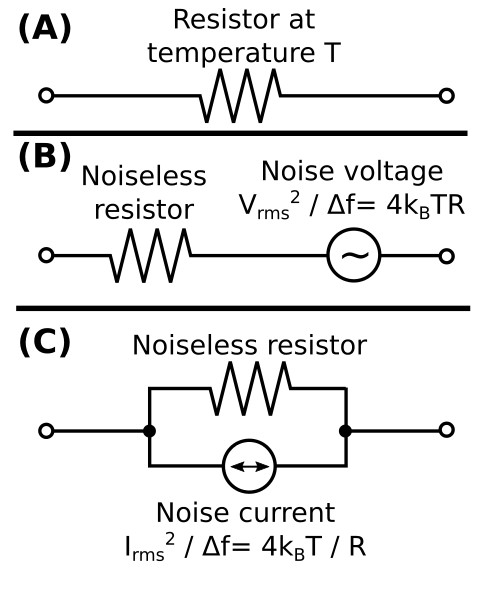
Fig. 4
Because it is random in nature, an instantaneous value cannot be predicted. Thus we are forced to handle these quantities typically as a RMS value. Fig. 4 shows how thermal noise is modelled: An ideal resistor with a noise generating source. Eq. 1 represents the RMS value of the noise over a finite bandwidth.

Eq. (1)
Studying power transfer in a purely resistive circuit can be a trivial exercise. However it forms the basis of this study. Fig. 5 shows a more general model than what is typically presented. We know that if Vload = 0, maximum power transfer happens when the source and load resistance are matched. Fig. 6 shows this situation where the source and load resistance are equal to 50 ohms.
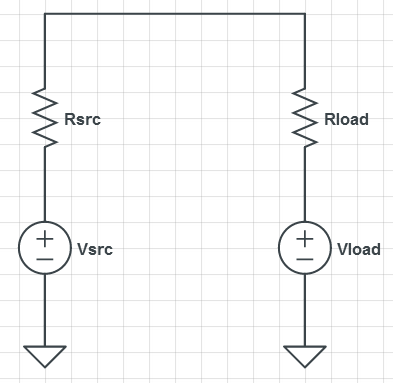
Fig. 5
If Vload is present, the analysis is similar, as shown in Eq. 2. Furthermore, the maximum power transfer is obtained under matched conditions, like the first case. The difference is that the value of Vload is significant. In Fig. 7, we see a simulation where Vsrc was set to 1V and Rsrc was set to 50 ohms. The blue trace is the matched condition. And as Vload is swept from 0 to 1V, the power dissipated by Rload reduces to zero.

Eq. (2)

It is important to note at this point that maximum power does not entail maximum efficiency. Eq. (3) demonstrates that under the matched condition, the efficiency is at most 50%.

Eq. (3)
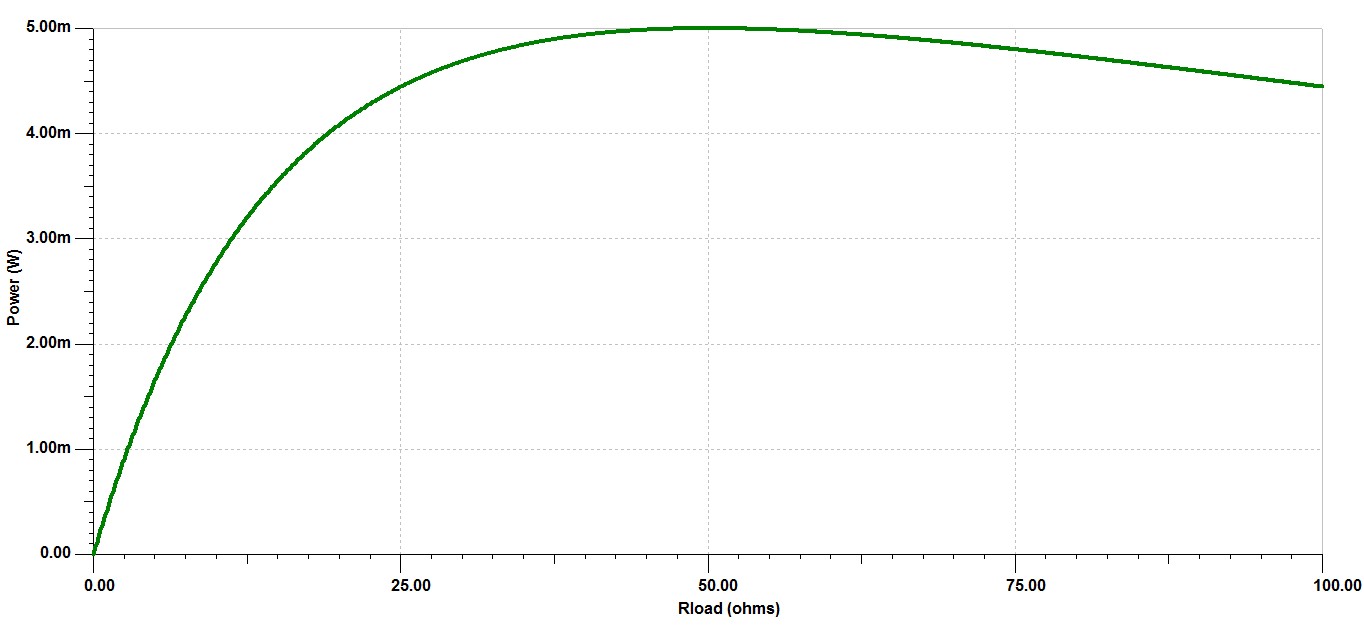
Fig. 6
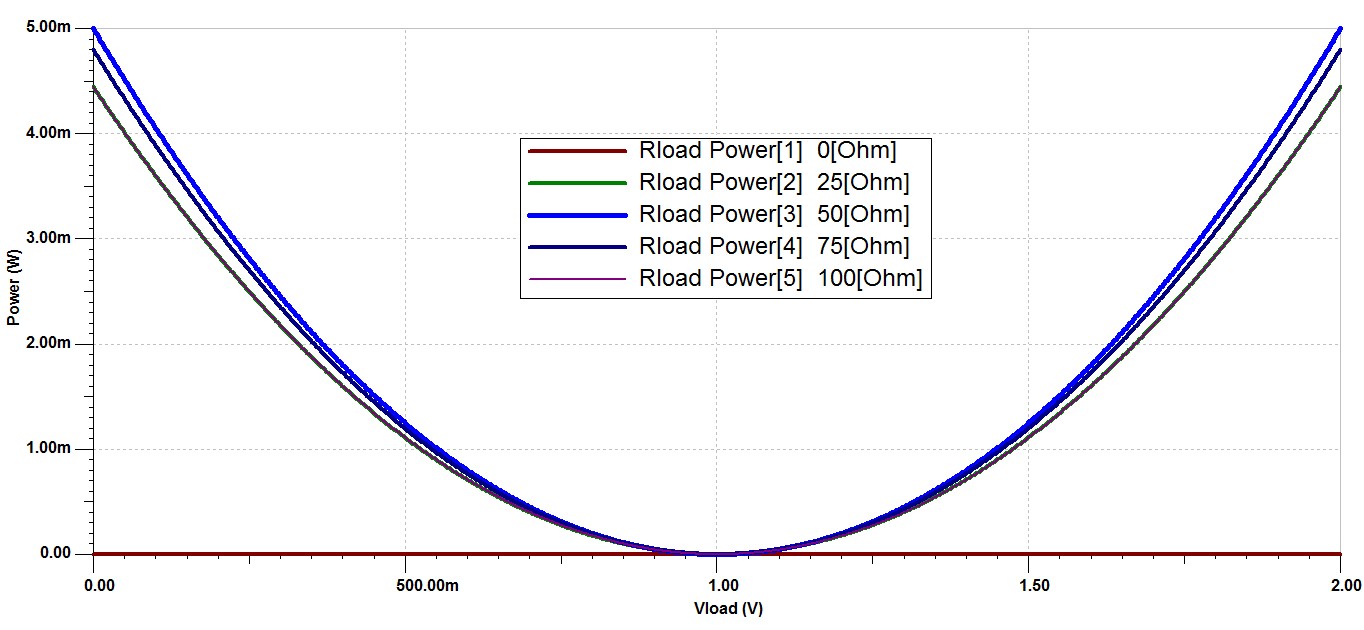
Fig. 7
Now if we assume Fig. 5 is an ideal model of Fig. 8, which shows thermal effects, it is apparent that power can be transferred between two noisy resistors. Assuming that both resistors are submerged in a temperature bath—that is held at a constant temperature—some quick analysis reveals some interesting results.
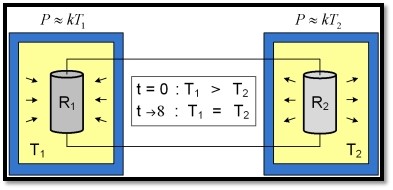
Fig. 8
For simplicity, we will first assume that Rload (R2 in Fig. 8) is held at T=0K. Therefore, Vload is 0. In this case, the power transferred to Rload from the thermal noise in Rsrc can be modelled by Eq. 5. It is noteworthy that under matched conditions, Eq. 6, the values of the resistors are irrelevant. Only the temperature and the bandwidth are important.

Eq. (5)
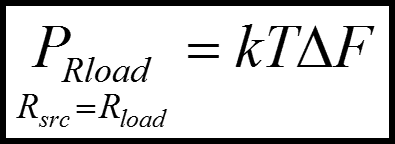
Eq. (6)

Eq. (7)
In the more general (and realistic) case that the temperature of Rload is larger than absolute zero, the analysis is a bit more involved. Now the Power transferred to Rload is shown in Eq. 7. The result is similar to Eq. 5, but now the temperature difference is important.
Eq. (8)
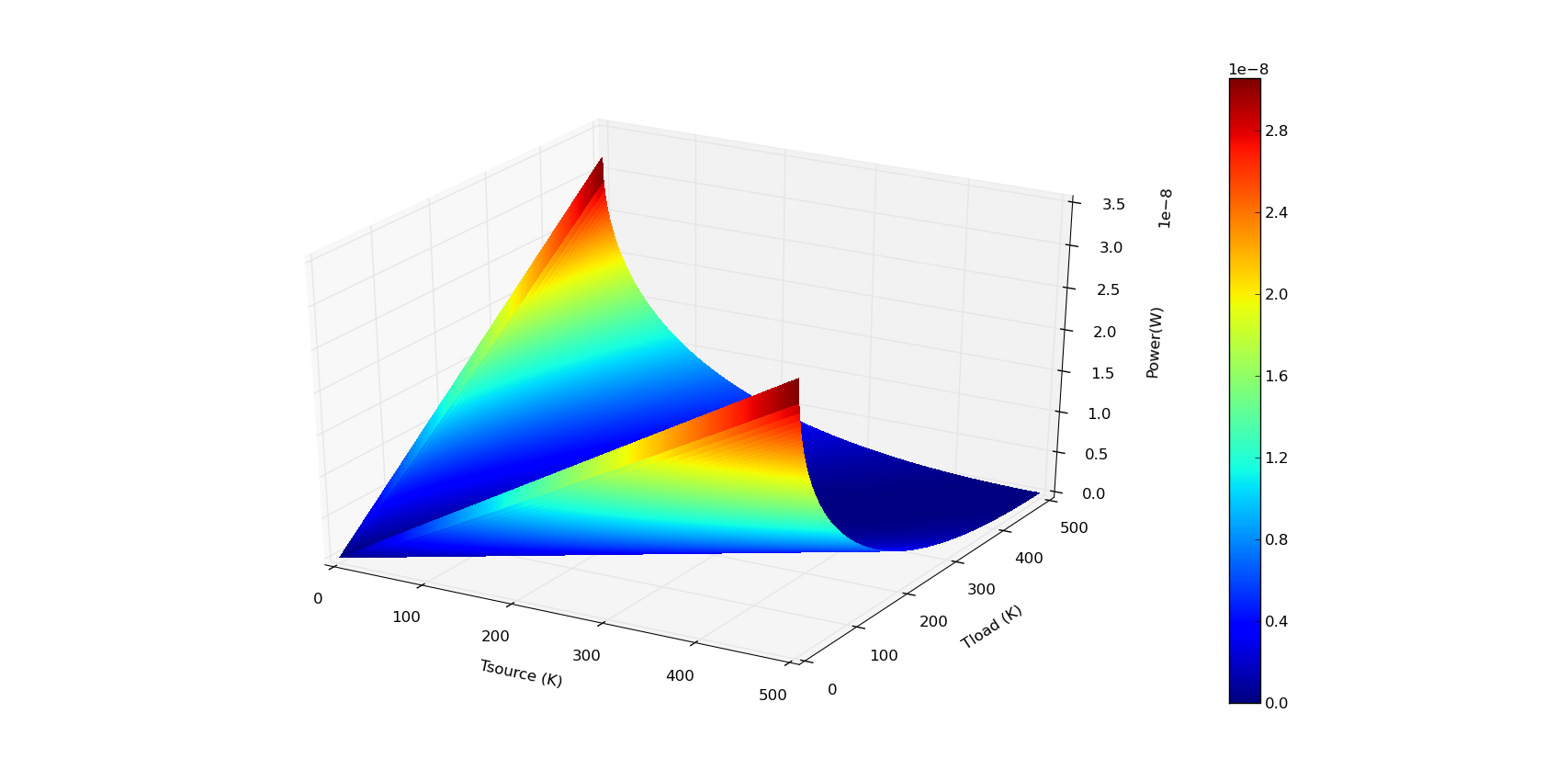
Fig. 9
Similarly, under the matched load condition, the resistor values cancel, and we are left the temperature difference and the bandwidth as the determining factors. Fig. 9 is a 3-d plot of the matched condition where the bandwidth is approximately 4.6THz. As described by Eq. 7 and 8, the greatest power transfer occurs when Tload is reduced to 0K.

Eq. (9)

Eq. (10)
Perhaps the biggest motivation in this project was determining whether arbitrarily small signals could be harvested. According to Eq. 10, the answer is yes, at least theoretically. Eq. 10 modifies Eq. 7 by simply adding in a voltage source in series with Rsrc. Holding the source resistor at 295K and assuming 4.6THz of bandwidth, Fig. 10 shows a 3-D plot of power transferred when Tload and Vsig are swept. What is apparent, in comparison to a diode, that when the signal voltage levels become extremely small, the power does not drop off as rapidly. As an added bonus, if Tload is less than Tsrc, thermal energy is harvested too!
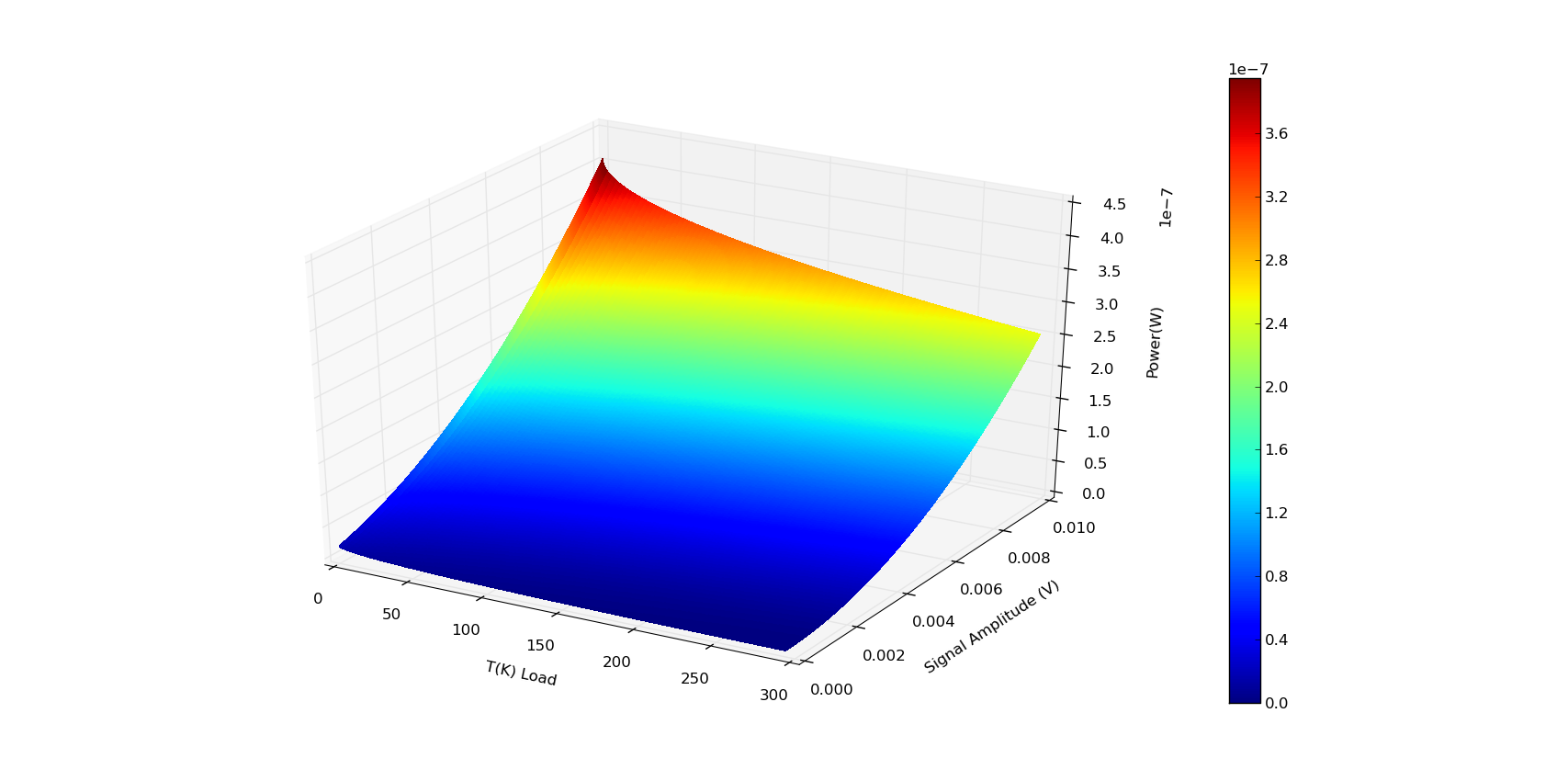
Fig. 10
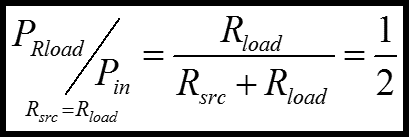
Eq. (11)

Eq. (12)

Eq. (13)
Again it is important to consider the efficiency, Eq. 11. All things considered, it shouldn’t be surprising that under matched conditions, the efficiency is 50%. However this value is somewhat misleading as it does not account for thermal efficiency, the power transferred from source to load due to a temperature difference. This relationship is shown in Eq. 12. What is most interesting is that when Tload=0K, the maximum efficiency is 25%. This is shown graphically in Fig. 11.
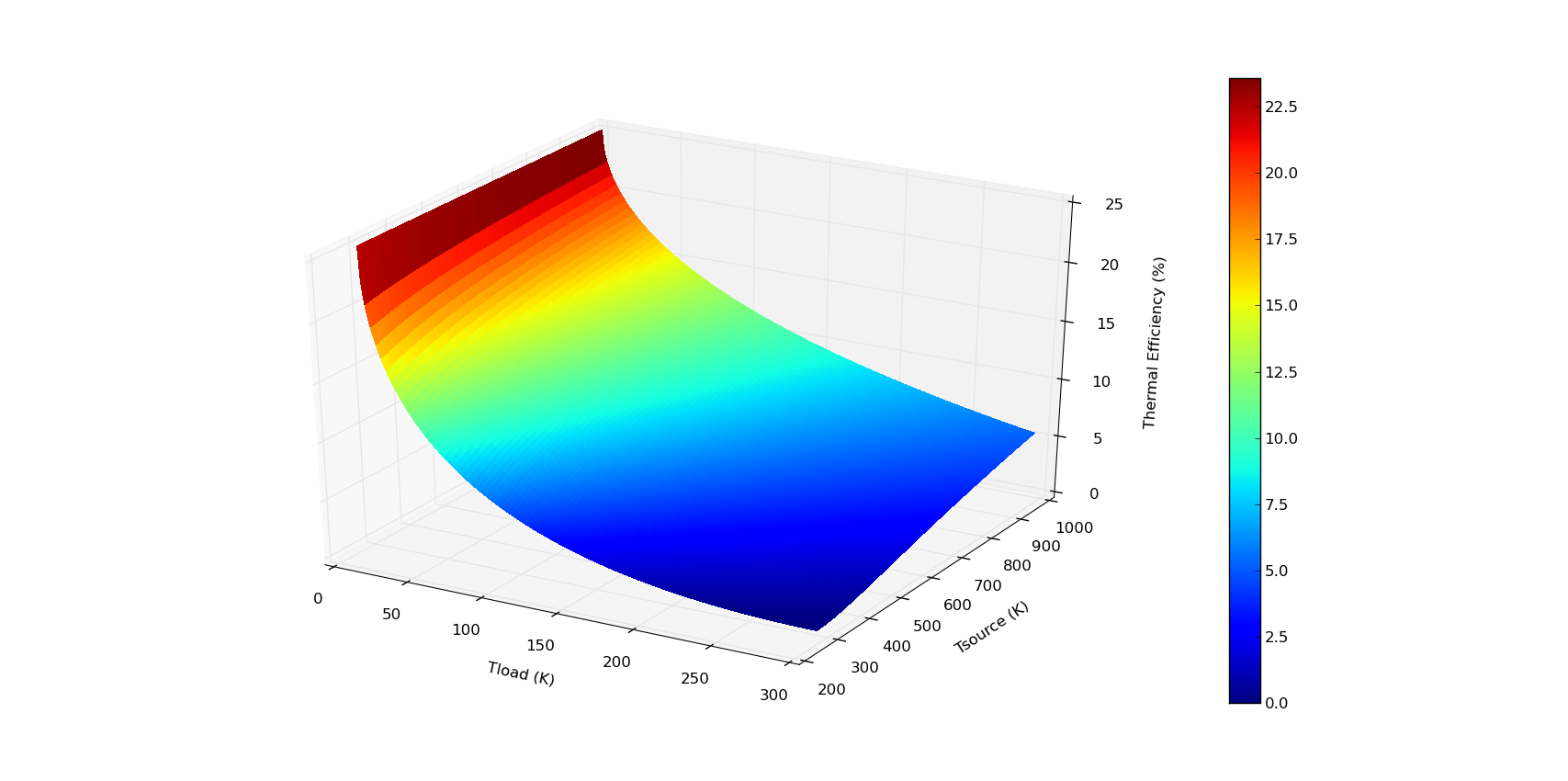
Fig. 11
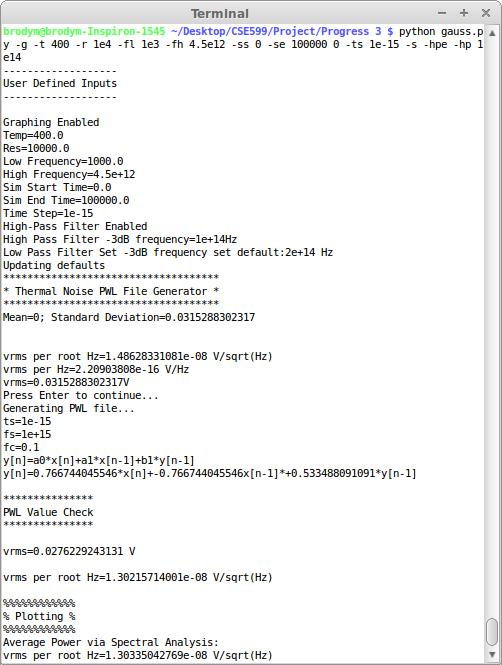
Fig. 12
To extend this investigation into a more practical realm, I decided to use commercial circuit simulators to gain more understanding. Most well-respected circuit simulators provide noise analysis techniques. However simulators do not behave well when no explicit source is defined. In other words, placing two resistors in series, with no designated source, results in errors.
Therefore, I was forced to use the model with an ideal resistor and a noise generating source, like Fig. 5. Unfortunately, this leads to a second problem: The lack of random sources! Fortunately most well-respected simulators allow importing piecewise linear files. To ensure the process was as realistic as possible, I developed a Python script than generates PWL files for a noisy resistor. Fig. 12 shows a console view with user input and script output. The script was designed to be extremely flexible. The user can define temperature, resistance, bandwidth, time step and simulation length. Although not used in the final simulations, I also included basic IIR low-pass and high-pass filters. The script uses the basic Johnson-Nyquist noise equations and generates a pseudo-random output based on the input parameters. Furthermore, the script compares the expected theoretical values to those generated by the random signal. If enabled by the user, a plot is displayed at the end of the PWL file generation. This process is shown in the Youtube video below. Fig. 13 and Fig. 14 are example output plots by the PWL file generator. Fig. 15 shows a test run in a simulator called TINA. What is shown is the noisy source and load output, modelled by a voltage source running PWL files. Vload is the voltage across the resistor of interest.
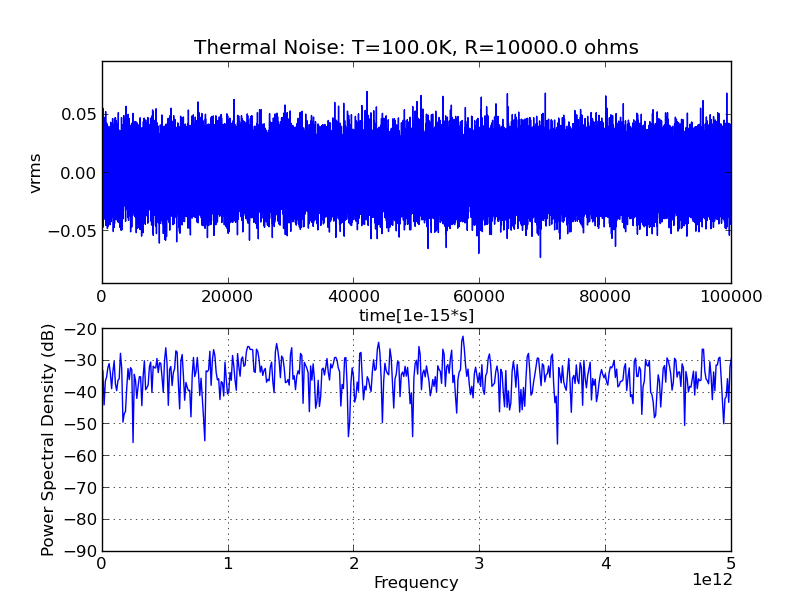
Fig. 13
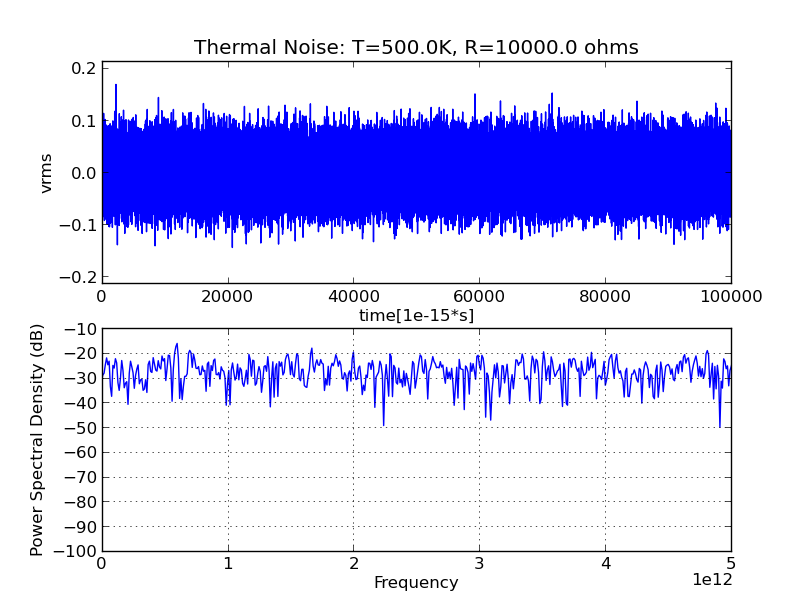
Fig. 14
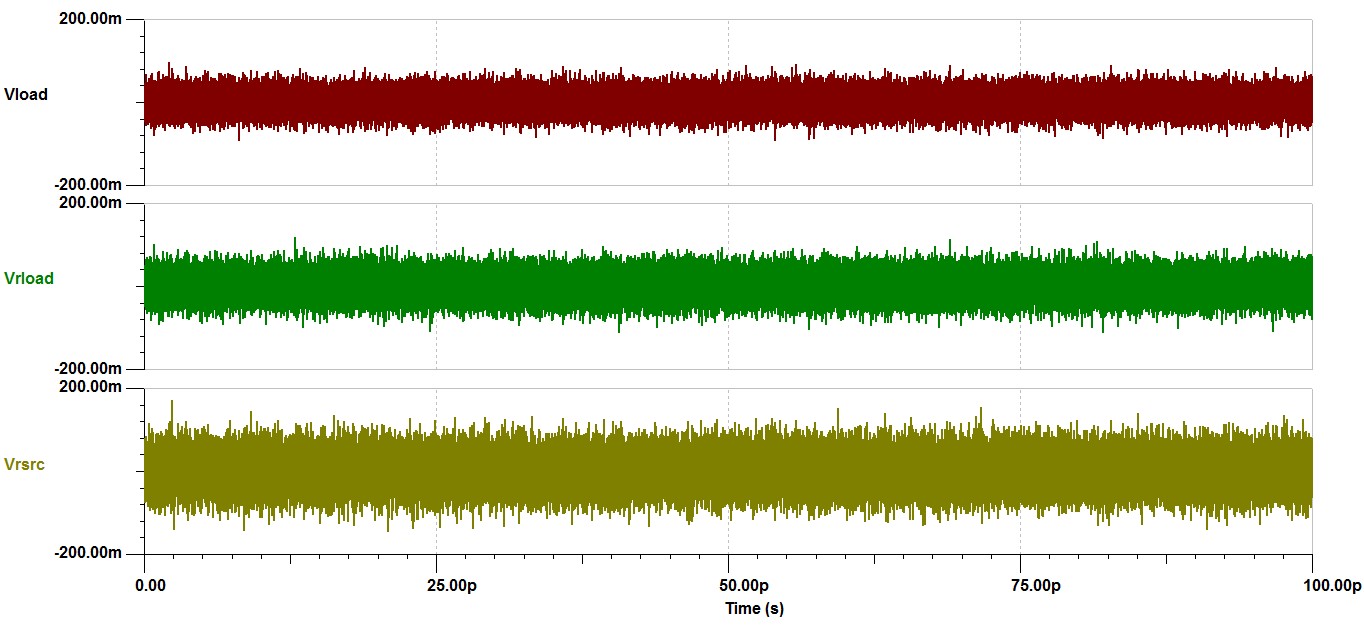
Fig. 15

Fig. 16
In an attempt to make the simulation more accurate, I decided to include a device that would convert the thermal energy to electrical energy. After some brief research, I decided to use TEGs. Real TEGs operate with respect to five phenomena: Seebeck Effect, Peltier Effect, Thomson Effect, Joule Heating and Thermal conductivity. Due to time constraints, only the Seebeck Effect, Joule Heating and to some extent Thermal conductivity was included in the simulation model. Eq. 14 is a simplified expression for the Seebeck Effect. Thus my model was a voltage source with an output that equaled the Seebeck coefficient multiplied by the temperature difference.

Eq. (14)
Fig. 17 shows the model I used in the following simulations. Expanding on that shown in Fig. 5, the dissipated heat flows through the TEG. Rint is the internal resistance of the TEG, while Rload models any arbitrary resistive load that we wish to transfer power to.
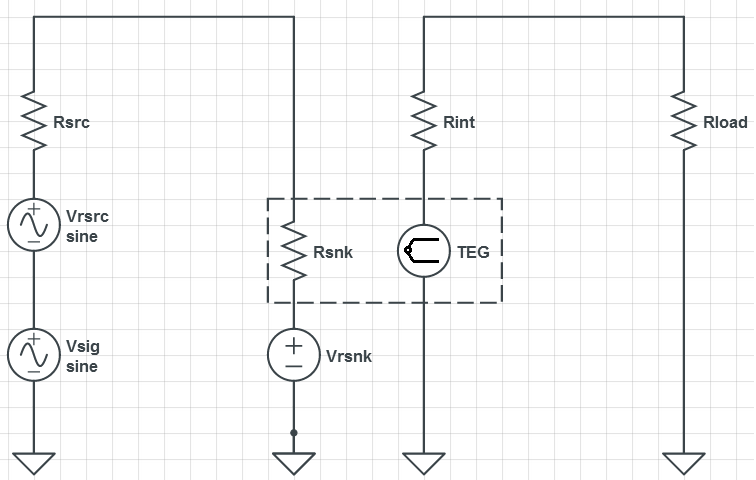
Fig. 17
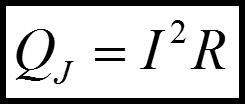
Eq. (15)

Eq. (16)

Eq. (17)

Eq. (18)

Eq. (19)
In this model, various assumptions were made. First, it was assumed that all heat dissipated by Rsnk was transferred through the TEG. More importantly, the system formed by Rsnk and TEG are in thermal equilibrium. In other works, the heat flowing out of Rsnk is exactly equal to the heat flowing into the hypothetical cold sink of the TEG. With this simplification, I was able to use Eq. 15 for Joule heating to directly couple Rsnk and Rload: Eq. 15 and 16. Eq. 17 is the final equation of the power transferred to Rload given the aforemention simplifications. Eq. 18 is an expression for the efficiency of the system.
Fig. 18
The system, as modelled in TINA, is shown in Fig. 18. For those not familiar with TINA, some of the extra components may look confusing. TINA uses an intuitive approach by requiring that virtual voltmeters, ammeters, and Watt meters be connected to the appropriate areas of the circuit. The large yellow block is the simple model of the TEG. It is a custom voltage controlled voltage source. (VCVS). The VCVS measures the voltages across Rsink and calculates the dissipated power. Based on the previous equations, a corresponding voltage is sources to the second half of the circuit.

Fig. 19
Fig. 19 is an example plot from the many simulations that were conducted with TINA. In Fig. 19, the output voltage of the TEG is not a steady value as would be expected. In this simulation run, instantaneous power was assumed (although this is a very incorrect assumption), which explains the pulsed voltage seen at Vload. This was done for this particular simulation simply to demonstrate that there was rectification.
Unfortunately, even when modeling correctly with RMS values and average power, the results were somewhat questionable. Some general trends were seen, but there were some inconsistencies after thorough testing. Even though the PWL files were verified after generation, reducing the temperature of Rsnk did not always result in more power transfer. This inconsistency was double checked with various simulations in Cadence Virtuoso. Furthermore, efficiencies were calculate in the 1e-9% range! When using sine waveforms, however, in place of noise waveforms, the above relationships did hold true. I am confident that my model is accurate, but there needs to be considerably more work regarding accurate simulation.
The thermoelectric rectifier is theoretically sound. By using the principles of Joule heating, an arbitrarily small signal can be harvested. And if a temperature difference exists, thermal energy may be directly harvested from the environment. In this case, the performance of the system behaves like a heat engine, albeit far below the Carnot efficiency. Furthermore, if DC electrical energy is desired, than the heat must be converted to electricity. In this project, TEGs were briefly explored. Although the simulations were overly-optimistic, it is possible to convert the heat energy with TEGs.
However, considering present-day commercially available devices, such a structure may be highly impractical. TEGs, in general, are very inefficient. Although research is extending the efficiency, 1% is not an unusual efficiency under normal operating conditions.[]. Also, it must be acknowledged that if the proposed device was constructed, it may be very large since it may require a cold sink other than the atmosphere. Additionally, complex circuitry may be required to effectively store the energy for use by a DC powered device. In this case, we may still be limited by the sensitivity of a charge pump.
Regardless, these devices may be practical in the future. Even if we are limited to 10% efficiency in the future, the amount of available power beyond the reach of traditional rectifier circuits would offset this deficiency. Therefore, more research is required. The resistor power transfer model needs to be developed and simulated to a much greater extent. More importantly, this concept must be demonstrated experimentally.